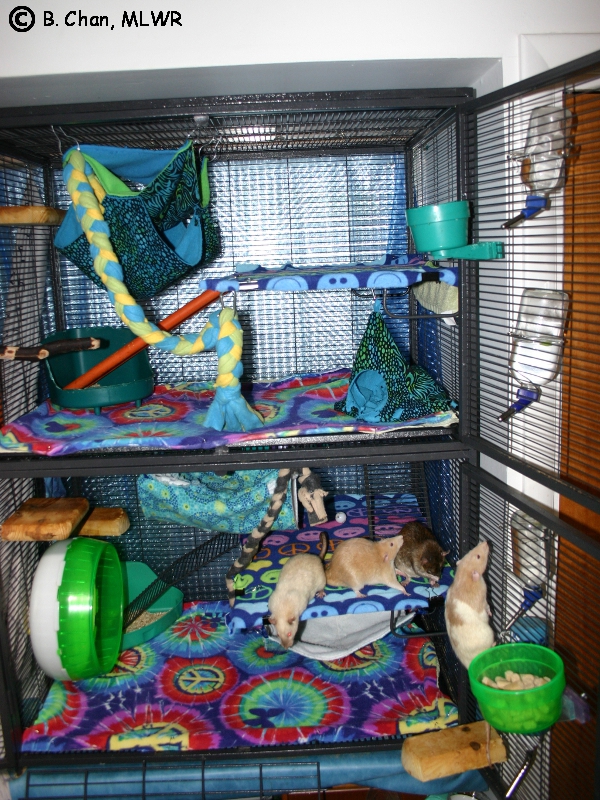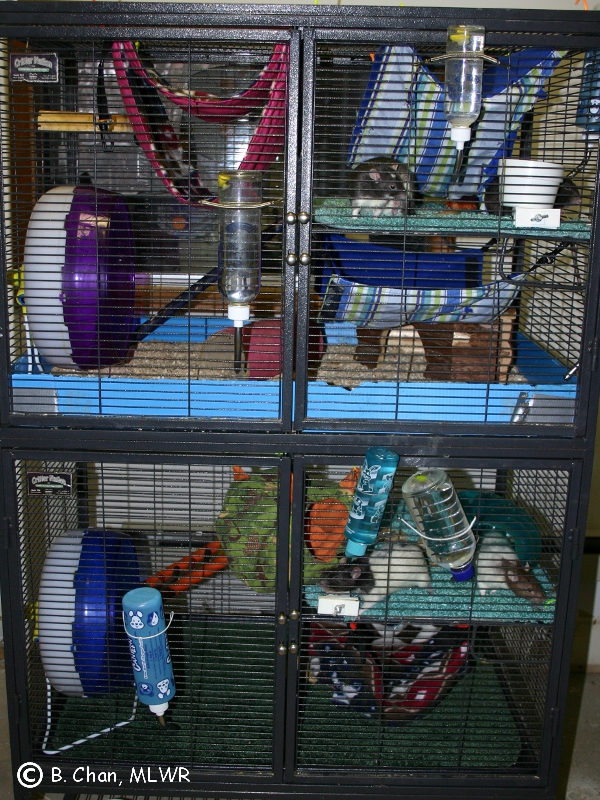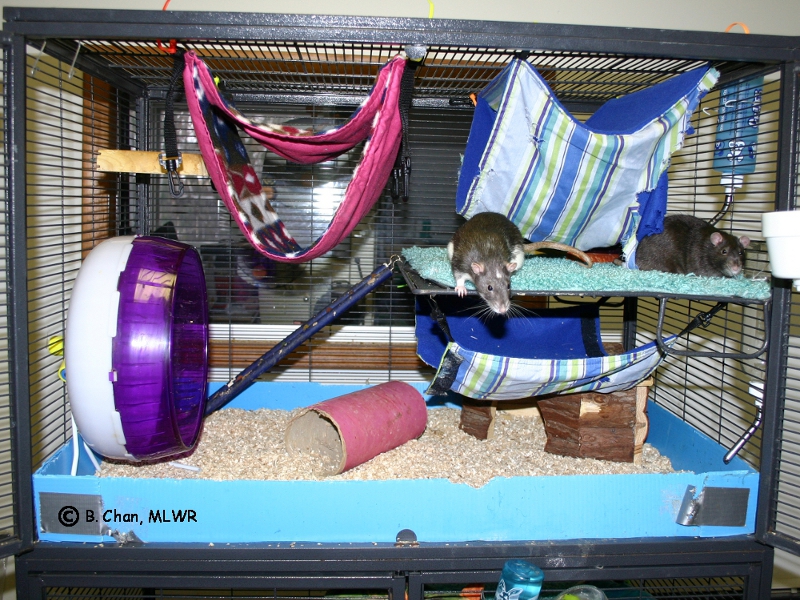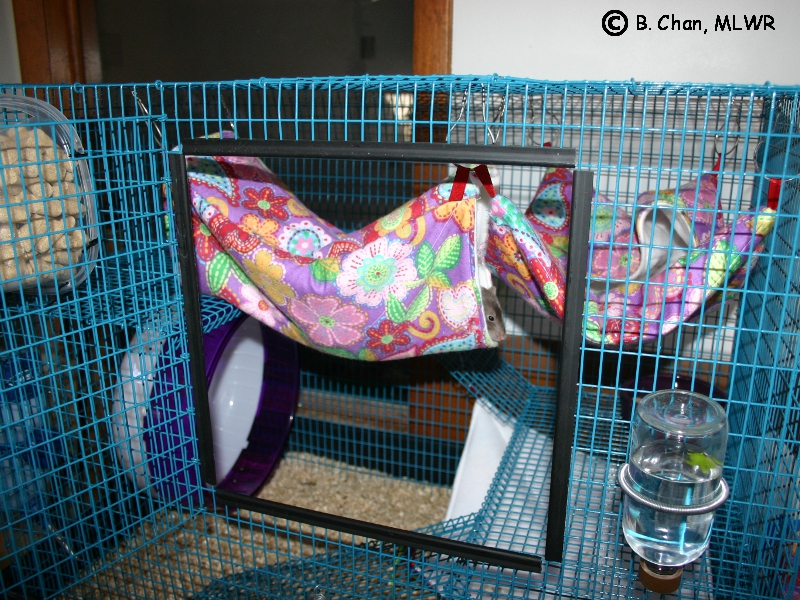

 |
 |
 |
 |
 |
 |
 |  |
 |
 |
 |
 |
 |
 |
 |
Here we will share information about the basic care we give our rats: our rat room, cages, bedding, accessories, diet, etc. We hope to add a webcam eventually when our rat room is finished so that people get a chance to see our rats running around live on the net!
We are currently in the process of remodeling a room in our home to be our rat room. It has new wiring, plumbing has been run for it to have its own sink installed, we poured a new subfloor and have tile to go over that. Much of the drywall has been redone, and the room is getting a new paint job. Not to mention a door being added onto the opening that leads to the room, with a small window next to it to see in, so that we can keep our ratties safe and happy. When its done, we will hopefully have not only our rat cages and supplies there, but a playpen setup, a chair for people to hang out in with the rats, a computer station for us to keep all of our rat information on, do updates from, print out forms and run the webcam, and a photo area so that we can keep the pictures of our rats up to date! We look forward to completing this project and sharing the results!
We have both martins cages and critter nation cages that we use at this time. We like these 2 cage types since the bar spacing is safe for rats of all sizes, genders, and ages - without any modification needed - which helps keep them all where they should be and protected from harm. We also like them because they give the rats ample room to play, climb, and explore, and room for hides, hammocks, wheels, and other cage accessories. They are well constructed cages which are easy to get into (with the newer models of martins at least!), provide great ventilation, and with regular maintenance are kept clean fairly easily. At this time we have 2 double critter nations in use, as well as a martins R-680 cage. We have in storage 2 martins R-695 cages and a martins R-685, all of which we anticipate using at some point - they all make excellent long term housing for multiple rats!

One of our double critter nation cages - open for the whole cage to be used by one group. (at the time of this picture there were 4 adult males who had the run of the whole cage!)

Our other double critter nation cage - this one is split into 2 separate cages (at the time of this picture, we had 2 senior guys living on the bottom, and 3 rescue rats living in the top level).

Showing the top level of our second double critter nation - we made a tray out of coroplast so that we could use sani-chips bedding in this cage. The 3 rescue rats, Yakko, Wakko, and Dot, live in here!

Our martins R-680 page (we repainted it due to wear exposing the metal under the powdercoat)

Another picture of our R-680, with some hammocks added! There are also 2 young girl rats hanging out in the tunnel hammock!
The bedding we use depends on the cage, but in those with deeper trays we like to use aspen chips. These are sold under the name of Sani-Chips by Harlan Teklad, but are also seen by different names under other companies. They are aspen, which is a hardwood and therefore doesn't carry the dangers of softwoods like pine and cedar, which we would NEVER recommend using. The sani-chips are small, relatively dust free, and do a good job of odor control. A drawback to them is they do scatter, but the other benefits they have outweigh this, and regular sweeping and vacuuming can keep that under control. They are light enough and small enough for vacuums to handle well. They also will go through the slots of most cat litter scoops well, while adult rat poop tends to get picked up by the scoops, allowing for daily spot cleaning of the cage without needing to dump out all the litter on a daily basis, so that it can be changed only when it gets soiled, or when full cage cleaning (generally 1-2 times a week depending on the number of rats in the cage, the cleanliness, etc) happens, whichever comes first.
The other bedding type we use in the critter nations that we don't have deeper trays for, and on the shelves of the critter nations, is fleece. We generally put a towel down first, and put the fleece over it, both for better aesthetics and to give a softer surface for the ratties with fewer loops to risk getting their nails stuck in. The towel helps absorb urine and other messes, and any poop can be cleaned off the fleece daily. The fleece and towels generally get changed at least a couple times a week, if not more often, depending on the rats again (some cages are better with litter training than others, and make less of a mess of their fleece!). Using fleece and towels can work really well if laundry and periodic replacement isn't an issue, and the cage can be cleaned a little more often - plus it allows for more decorating of the cages!
We make sure all our cages (except future maternity bins, for safety reasons) have safe wheels in them for our rats to use of they so choose. Even cages with older animals have wheels present - some just prefer to sleep in them, but I've seen rats with hind end weakness, nearly 3 years of age, get themselves over to their silent spinner to take a stroll (one with his front legs only while he sat on the fleece outside the wheel ). So even with rats that don't seem to use the wheels much, we want to make sure they are always available to them.
At this time we are mostly using silent spinners - the rats don't seem to chew the plastic of them, they turn well, they have a solid surface so no caught feet or tails, and there is no crossbar on the entrance or through the middle to cause any injuries. We are looking at certain styles of mesh wheels as well, ones lacking the cross bars as well (most in that design are only open on one side), since the mesh still keeps feet safe, while reducing urine buildup from rats who use their wheel frequently. Stealth wheels are another interesting product we've looked at, and we do have a Wodent Wheel that is as of yet untried, that seems relatively safe, though the openings do cause a crossbar like problem, but are situated in such a way that it shouldn't be an issue on those.
We also make sure all our cages have several hammocks in them, to give rats more climbing space, as well as places to nap, hang out, stash food, and and play in. Offering a variety of hammocks usually means everyone can find one in a style and area of the cage they prefer, and if they want alone time they can still find a comfortable place to be, but there are also large hammocks easily able to hold several rats at once and have them be happy. Rat can and in most cases will chew up and destroy hammocks eventually, so we always check to make sure there are no dangerous holes (small enough to get a leg or head caught), and make sure to remove hammocks from the rotation that are no longer fit for use. Because of this we have to make sure to regularly get replacement hammocks so that we always have clean and safe ones available when doing cage maintenance, but its worth it for how much the rats love them!
We also like to make sure there are hiding spaces available to our rats, to help them have a secure place to go if needed. For some cages this is a wooden hide (though these have short lifespans due to their inability to be cleaned), other have igloo type cages, and some have hammock cubes set up on the ground so that they provide a fabric hide to run to. In many cases these areas end up being used for food storage by the rats as well!
Our staple diet is Harlan Teklad 2018 lab blocks. These are a very high quality, nutritionally complete food that gives our animals of all ages what they need to grow and be healthy. It has been formulated to be a very safe and healthy food, and is ideal for our rats. We know there has been a lot of noise recently about soy in rat diets, and HT does have a small amount of soy in it, but it is our belief, through research we and others we know and trust have done, and studies that we have found which use correct, scientific methods, that soy is not only safe in moderation, but potentially beneficial. A fellow breeder has written an excellent article addressing this issue here.
In addition to the lab blocks, our rats get supplements of fresh fruits and veggies, eggs, pasta, grains, some seeds (limited for their health!), occasional bits of meat and whatever we happen to be having (as long as it is rat safe food!). These supplements help add variety and given them the chance to enjoy different items, but the core diet of the blocks helps ensure they get proper nutrition. For treats we generally use the puff treats often sold in canisters by Gerber, Parent's Choice, and other companies as finger snacks for toddlers. These are relatively inexpensive, a perfect, small size for little ratties, and are significantly healthier than treats like yogies which are almost all sugar.